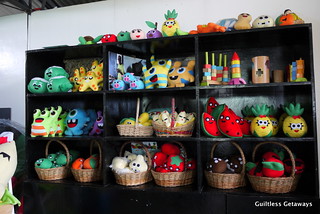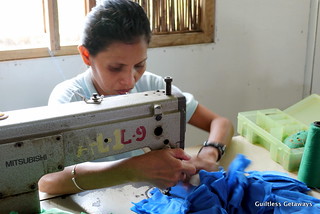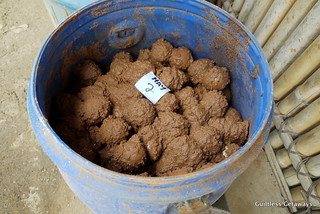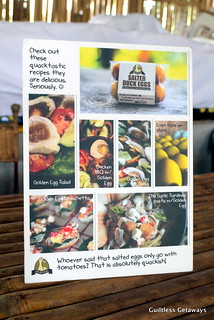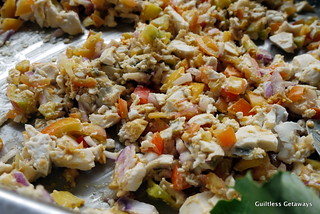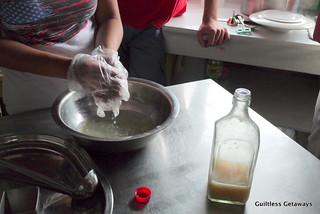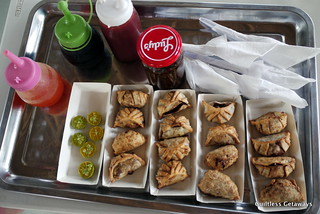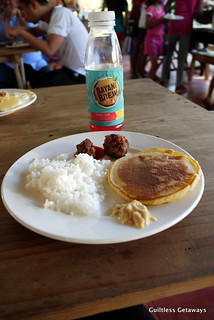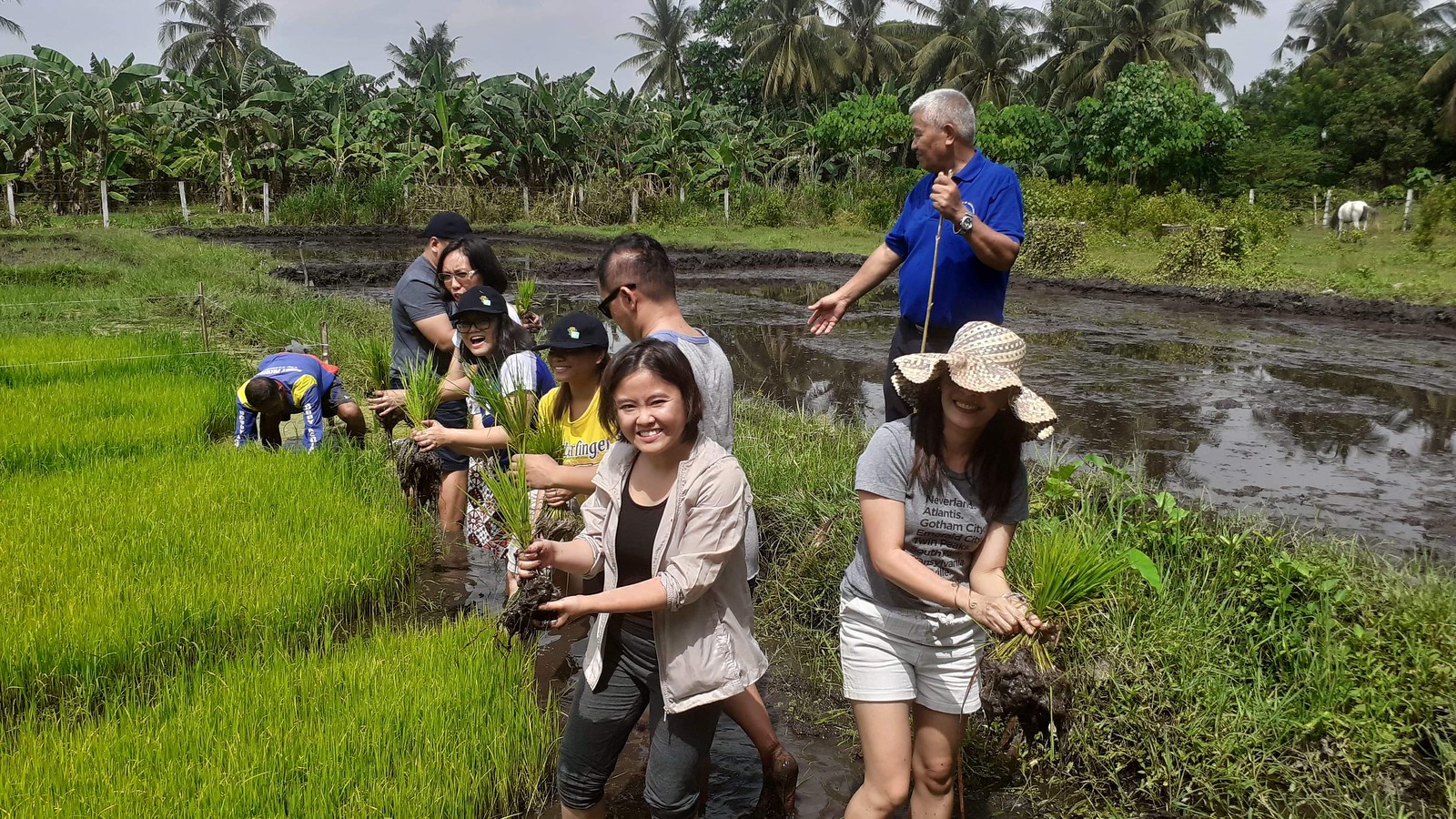What do you do on your weekends? For some of us, we cherish this moment away from work and spend it on a getaway. For me, it is usually a day for blogging and more things to be done because I love scheduling my solo trips on weekdays ;) These young social entrepreneurs at the GK Enchanted Farm spend their days working on their dream projects and being with the community they now consider as family.
It was a great overnight experience in a sense (except for the lodging...but you can just do a day tour) because I got to meet some of them (and we're more or less in the same age group) and they chose a career path that they are passionate about like me.
We first visited the hut of the nanays of Plush N' Play. Bulacan, particularly Angat they said, used to have a textile industry that died down. Fabian Courteille (French) chose to create a social enterprise with the Nanays who were expert sewers like Ate Prida below. Look at the partnership this way - Fabian can't sew but he can make business plans and do the marketing.
These were their creations - each one recognizable as Pinoy with their names (derived from famous local personalities) coined by the Nanays.
Even on a Saturday, they were hard at work but happy, they said, because they could look after the kids here while they earn additional income for their families and even work at home (just a few steps away). With this setup, there were able to lower their costs as well. Development entails not only an increase in earnings but a decrease in cost too.
Presenting Mais Ganda (from Vice Ganda) hahaha, complete with tattoos and all, with Jessica Saging. There's one named Pipinoy too LOL.
The Goldenduck hut was nearby.
This is our GK guide and social entrepreneur, Alvie Benitez, and his pride and joy are the renowned golden eggs.
The common salted egg (itlog na maalat) made from duck eggs in the market is easily identified with its purple color. We don't know what sort of food coloring they use but for the golden eggs, it's turmeric ginger (read about its benefits), termite wall (surprisingly) and salt.
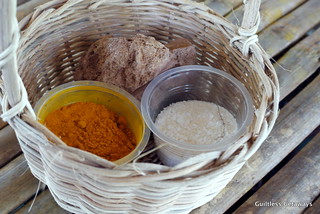
Alvie also said that aside from the "toxic" dye, too much salt is also a problem for traditional salted eggs in the market. Here, their claylike rock salt to soil solution is at 1:1. Looks like poo at this stage, huh? Haha. At least you know how they make it.
The termite wall goes back to the ground after one use. I think they also have an eco-friendly solution for discarding the salty mixture. They keep the eggs for 15 days, wash them, boil them then dip them in turmeric for that golden glow.
They're still experimenting with the incubators. Hopefully, they can have more breakthroughs and increase their supply enough to bring the price down in the near future. They use itik (mallard) / "wild" duck eggs fed with Azola because of many factors. Alvie said that it's the recommended animal for Asia but just a few see this potential. These ducks are resilient and require no antibiotics (they don't get sick during the rainy season being half-breeds) and they can survive floods (the farm got flooded before and these ducks were just found swimming) ;)
The shelf life of the Golden Eggs is 3 weeks at room temperature and 45 days in the fridge. A pack of 6 can be bought at P140.
Alvie described duck meat as gamey and I personally don't have a fondness for the strong taste of anything labeled duck (doesn't matter if its "pato" - Peking duck, "bibe" - White or "itik" - mallard chicken half-breeds..). According to Alvie, the male mallard ducks are even better tasting than Peking duck and nobody wants them (probably because they don't lay eggs?). With their social enterprise though, they hope to make ducks sexy through creative taste tests like the case of their duck burgers (made with male mallard meat)
and actually serving the Golden Eggs at the Enchanted Farm's Grassroots Kitchen. I believe the Philippine foodie market would welcome new innovations, discoveries and presentations like this from businesses (like how Goldenduck is revolutionizing the duck industry) if explained well.
Gourmet Keso was started by social entrepreneur Addison Falcon. It was one of my favorite hut spots because it teaches you a skill that you can take home with you like a fun science experiment. It also made the cheesemaking process relatively simple and actually doable (by a normal person) in my eyes. Here are Ate Maricel who did the demo for our group with Paul (in his gap year from France) who is helping out on the food tech side of this business. Like the Nanays of Plush N' Play, she also said that she's happy about the opportunities that were made available to her here. She had an offer to go work as a domestic helper (DH/OFW) in Hong Kong but she stayed saying that if she got it right, she will help not only her family in the process. She said that the milk we buy is processed milk from the US but farmers make better milk. She shared with us her recipe where this social enterprise started from. It's been a family recipe since she was 8 years old.
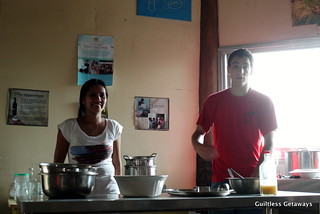
It starts with just fresh carabao's milk and coconut vinegar as ingredients. The milk is pasteurized for 20 minutes - boiled to 50 - 70 degrees to kill bacteria while maintaining the proteins using a double broiler. She mixed 2 cups of very hot milk to 0.5 cups of coco vinegar (can also use lemon juice they said).

then put in a brine solution of 3 cups water to 1 cup rock salt for about 5 to 10 minutes (I think they said 7 was good).
The last step would be draining the cheese for around half an hour. Tada - freshly made white cheese or kesong puti! Ate Maricel says she can make cheese from around 10L a day. You see the one with spots made by volunteers in our group? It can occur when you're still new at this but they said it's fine haha. Paul is working on powdered rennet enzyme instead of vinegar so that there are no yellow spots in the white cheese.
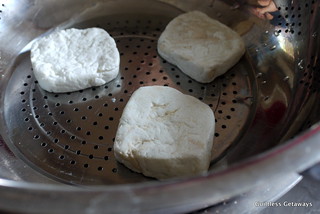
Gourmet Keso sells Kesong Puti (white cheese) in plain, garlic & herbs and garlic, basil & malunggay, as well as Cream Cheese (which takes 2 days to make).

I had to stop myself from munching on too much of the plain kind LOL. You have got to try it freshly made like that. Now I just have to get carabao's milk (gatas ng kalabao, heard there's a Philippine Carabao Center...) and coco vinegar in Manila or just drop by the Enchanted Farm Cafe in Quezon City...
We were introduced to Theo Chua of Theo & Philo Artisan Chocolates next and led to the most fragrant area of the GK Enchanted Farm =) He lived in Pittsburg for a while and decided to come back here to do this enterprise. Cacao, he said, can only grow in the equator and none of the countries that are famous for chocolate produce cocoa (processed cacao bean products).

The cacao fruit / pod is fermented and the beans harvested. The farmers dry the beans out in beds then dry roast them in open flame until a popping sound is heard (because they only want the inside).

Theo had a very simple solution and used a blower! Hahaha. He got the bigger ones that haven't been cracked open and made them go through the cracker once again
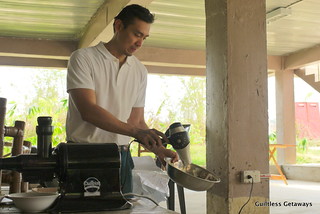
until all that's left are the nibs one can eat already. I didn't try it as I was allergic (but it was very tempting because of the aroma of the place - no kidding) but he said it's a good snack and might still bitter or sour from the fermentation.
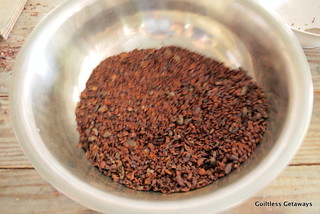
He ground the nibs with the grinder and I was actually surprised when it turned into a paste (and not powder). He said that's because it's 50% fat and the oil is released.
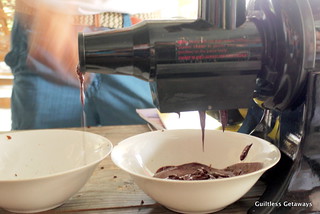
When this hardens, it becomes what we know as tablea =D If you take out fat from the tablea, it's cocoa powder. The fat is cocoa butter. If you mix cocoa butter, sugar and milk, it's white chocolate. Compound chocolate has vegetable oil. And there are still a lot of processes involved like conching, heating, adding ingredients, etc. to turn it into yumminess that we're familiar with. It's way easier to open a well-made packet and help the economy, right? Haha.

He said that the cacao bean used, the roasting and process affect the different flavors of chocolate. Theo & Philo source their cacao from Davao and the cocoa magic happens in Binondo =)

I've heard their best sellers are the adobo-flavored and the ones with toyo (soy sauce) and calamansi. Interesting, right? Sigh... they're so tempting whenever I see them in stores... perfect size too. The shelf life is about 6 months to a year.

We found Tita Lolit (right) hard at work at the Hamon booth at the Grassroots Kitchen. They're part of the social enterprise Hamlet, which was started by John Paul Bernardo (who is working and a social entrepreneur at the same time).
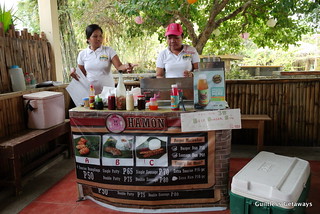
They're exploring the food stall and crowdsourcing model. They utilized Tita Lolit's recipes for this venture.

Hope these young and educated social entrepreneurs also reach out to experienced and generous farmers all over the Philippines who already have technologies for growing their products in order to expand and/or establish their businesses for the future. They might just create more impact and advance faster by doing things together.
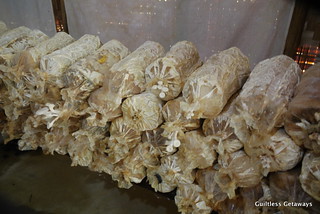
Other social initiatives include the Ube Jam, the Clean Ice Cream (a rebrand of the dirty ice cream) by Erika Ngwong,
and so many more that are undergoing the accelerator program offered by the mother social enterprise that is THE GK Enchanted Farm. There's the already successful Bayani Brew led by Shanon Khadka, Ron Dizon and Xilca Alvarez - I was already gulping bottles of it at SRP in the farm.. I talked about the "genius of the poor" in previous post. They said that the people living in the area before used to drink this purple kamote drink to prevent mosquito bites and with R&D, it was transformed into this Bayani Brew drink for the mass market ;) I encountered a very fresh one made in the organic farm of Mr. Renato Catiempo in Bago City, Negros Occidental =)
Finally, as the sweet ending to the stories, we encountered these jars of golden honey at breakfast. I was going to ignore them as I find honey to be sour (based on those I found in stores).

Lo and behold, TJ introduced himself to us and The Bee Empire that Sunday morn. He enlightened us that this is actually not the case and said that sour honey only comes from stingless bees. He had lots of bee stories that made me wish we met him earlier :) He told us about his bee farm in Antipolo and his project here at the GK Farm. He let us taste the difference of this fruity (monocrop) honey made from acacia trees and the multi-floral one (where bees gather from different flowers planted within a 3 mile radius). It was actually the first time I've heard of bees getting nectar from trees and bee farmers planting specific trees to affect the honey so my questions just kept pouring in. Like if he's been stung already (he said LOTS), telling us about the honey gathering process, which brands are fake honey, the different kinds of bees and many more. Hehe. Here in the farm, the bees live near mango and avocado trees so the batch made here would also taste different. :) I wonder what honey made from pineapple flowers from Bukidnon that he told us about would taste... I asked him about being allergic to pollen (me) and he said that there's a possibility that I can help myself by exposure to honey from that area..
How to tell if it's the pure kind and/or the real honey? Drop it in water (in continuous drips) and it will not dissolve as fast if it's the real thing (I think it's not supposed to become solid at the bottom as well). Or burn it and it should be fast. He said that pure honey has no water. It's called adulterated honey if sugar, glucose and the like has been added. Wild bees (wild honey) also have very big honey combs so if they say wild in the label with small honeycombs inside then it might just be fake honey.. The heavier the honey, the better the quality it is as well, he said.
Anyway, the acacia honey had a sweet smell, was smooth and had a darker color. They are only available from March to April ;) The multi-floral was lighter and tasted like coconut or something like that. Before we knew it, it was already time to go :(
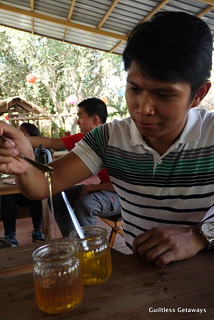
For all or most of the products featured here, as well as yummy cheese sticks and chips, you can buy them at the Enchanted Farm Cafe in Commonwealth, Quezon City.

I would recommend reserving ahead if you want to go for a day tour at the Gawad Kalinga Enchanted Farm in Angat, Bulacan =) I believe that you can find most of the social entrepreneurs at the Grassroots Kitchen on a hot day or just roaming around the farm on Sundays ;)
Farm near Manila Less Than 2 Hours Away - Activities at the Gawad Kalinga Enchanted Farm in Bulacan! - Part 2 of 2
Farm Details:
California Street, Pangi Angat Road,
Angat, Bulacan, Philippines
Open Tuesdays to Sundays 7:30 a.m. to 4 p.m.
Website, How to Get There, Activities, Accommodation and Fees
Step by Step Directions to the GK Farm
Step by Step Directions to the GK Farm
info@gkenchantedfarm.com
0916-2253363



